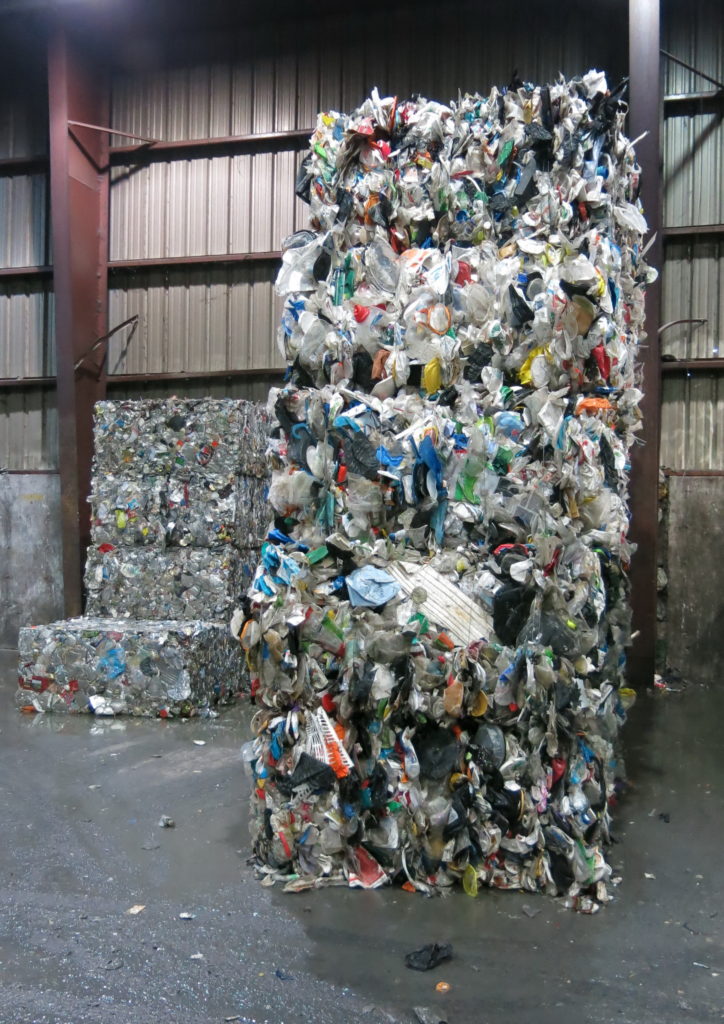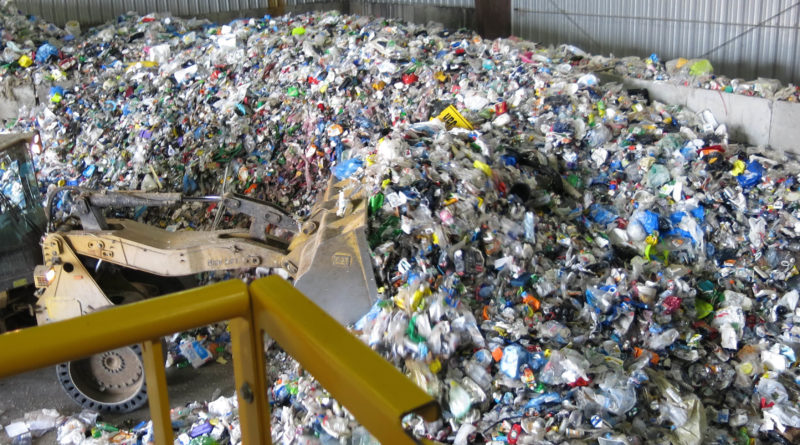From jug to Frisbee: recyclables, where they go and how they get there
Larry Newman

Recycling is a big business. Although the City collects the material in blue, black, and green bins, others do the separation and processing into marketable products. Processing equipment, especially for plastics and metals, is now quite mechanized or automated with humans basically doing quality control and management.
For Ottawa, Cascades Recovery at 2811 Sheffield Road is where the processing takes place. The City collects and transports the material to Cascades and Cascades separates the various kinds of material and bundles/bales it for shipping. Once a month, the City accepts bids for each of the fourteen different post-consumer products that Cascades extracts from our recycled material. The highest bidder arranges transport and takes it away for use in making other products.
This is the third of three articles that trace the route taken by our recyclables from curbside to new product. This article will concentrate on the products produced from blue bin material.
If you go to the “Waste Explorer” page of the City of Ottawa web site (easily reached by googling Waste Explorer Ottawa), you will see a list 88 pages long of materials that can be recycled—or not. This was created to answer the question, “Where do I put this thing now that I’m done with it?” The list includes 55 kinds of things that you can put in the blue bin!
There are many different kinds of glass, plastic, and metal. However, not all kinds of glass, plastic, and metal are eligible. For example, you should not put a drinking glass (broken or not) in the blue bin. Hard plastics are a no-no as are plastic motor oil containers. No scrap iron or clothes hangers, either. And especially, no plastic bags or batteries (two auto batteries were found in the recycle material on the day I toured the plant).
PLASTICS
There are many kinds of plastics. Somewhere on most plastics is a recycle sign, usually a triangle with sides that have arrowheads, all going in one direction. Inside this triangle will be a number, one through seven.
Number one is Polyethylene terephthalate. It’s used in water and pop bottles and in some packaging. It’s made for single use because repeated use increases the buildup of bacteria and carcinogens may leach out into the liquid. It’s crushed and shredded and made into pop bottles (about 25% of recycled material) or spun into polyester fibre. The fibre is reprocessed into fleece clothing, carpets, backpacks, stuffing for pillows and life jackets.
Some fun facts:
- It takes about 10 bottles to make enough plastic fibre to make a new T-shirt.
- It takes 63 bottles to make a sweater.
- It takes only 14 bottles to create enough insulation (fibrefill) for a ski jacket. And 114 bottles to make enough insulation (fibrefill) for a sleeping bag
- It takes only 14 bottles to create enough insulation (fibrefill) for a ski jacket. And 114 bottles to make enough insulation (fibrefill) for a sleeping bag
Number two plastic is HDPE, high density polyethylene, the plastic found in milk jugs, detergent and oil bottles, toys and some plastic bags. It’s a safe plastic and simple to re-process into picnic tables, plastic lumber, bed liners for trucks, Frisbees, etc.
Number three is Polyvinyl chloride, PVC. This is the soft, flexible plastic in food wrapping, children’s toys, and blister packaging. It’s also used to make plastic plumbing pipes, window frames, hoses and many other products used outdoors. PVC contains numerous toxins which can leach out during use. Recycled PVC products are not recyclable.
Number four, low density Polyethylene, LDPE, is found in shrink wraps, squeezable bottles and the type of plastic bags used to package bread. Some clothing is made with this plastic. It is also recycled into lumber, landscaping boards, floor tiles, garbage can liners.
Number five, Polypropylene, PP, is tough, lightweight and makes a good barrier to moisture, grease, and chemicals. It’s a cereal box liner, pail, bottle top, potato chip bag, packing tape, and rope. PP is recycled into landscaping border stripping, battery cases, brooms, bins and trays. PP is safe for reuse.
Number six is Polystyrene, PS, a very lightweight, airy plastic. It’s in Styrofoam drinking cups, egg cartons, foam packaging and insulation. PS is widely used but rarely recycled. In the U.S., it is said to account for 35% of landfill material.
Number seven is a catchall category for all polycarbonate, PC, and “other” plastics. It should not be reused as containers may leach BPA (Bisphenol A) which is a known endocrine disruptor. They are found in water cooler bottles, liners for canned food, as well as car parts. (formerly used for baby bottles and sippy cups BPA was banned from them in 2008.) Number 7s are not for reuse unless they have the initials, PLA, which is a compostable coding.
GLASS
Bottles and jars are the primary feedstock for recycling. Metals and plastic are separated from the glass, then the glass is sorted for colour. Only clear is used to remake bottles. The clear glass is mixed with soda ash and limestone and melted at 2700oC. Recycled bottles and jars make more bottles and jars as well as glassware. The coloured glass is used to make decorator items, counters, tiles, fibreglass, and as a component in road surfacing. Some of it is formed into small beads and imbedded into paint that is used to paint lines on roads. The glass beads reflect light and make it easier for the motorist to see the lines.
METAL
Aluminum is infinitely recyclable and retains its properties forever. [The Aluminum Association]. Aluminum cans are used primarily to make new aluminum cans. The recycled cans are cleaned mechanically and chemically and heated in a furnace to 750oC and poured off to make aluminum ingots. This new/used aluminum is also used in the manufacture of airplane and bicycle parts, pie plates, aluminum foil, and house siding. Virtually anything that can be made of aluminum can be made from recycled aluminum.
Steel is found in “tin” cans which are steel cans with a tin coating to protect the contents from being affected by rust from the steel. After cans are collected they are de-tinned by dissolving the tin from the steel for reuse. The resulting solution, sodium stannate, is filtered, then chemically treated to remove other metals. It then undergoes electrolysis in which tin is formed on one electrode, to be melted off as nearly pure tin.
Tin is used in tin cans of course but also used in the chemical and pharmaceutical industries as well as combined with other metals to make solder, pewter, and bronze products.
There you have it—the number of products made from recycled material is substantial and impressive. The next time you think about throwing out that plastic jug, remember—it’s a Frisbee in the making!
